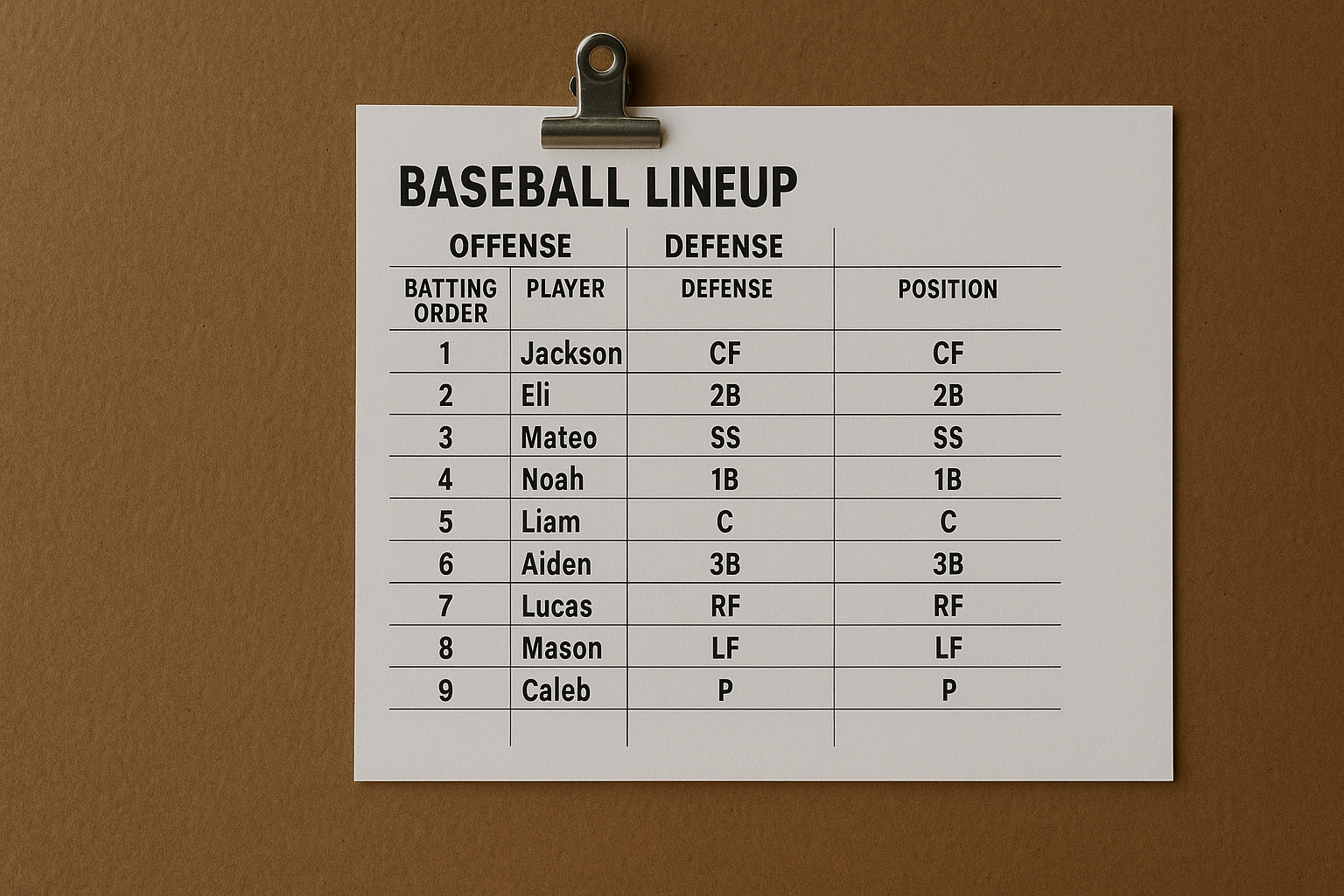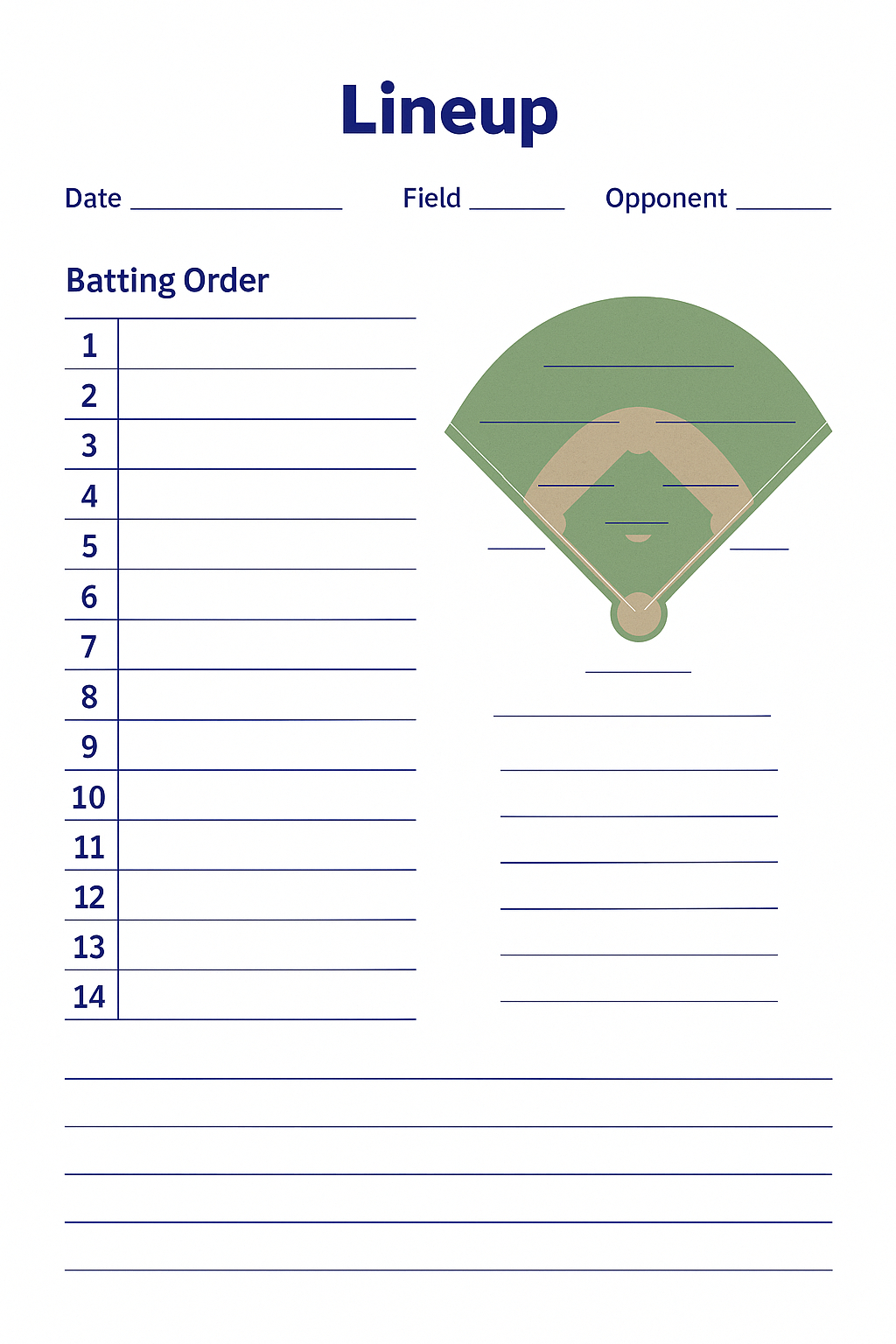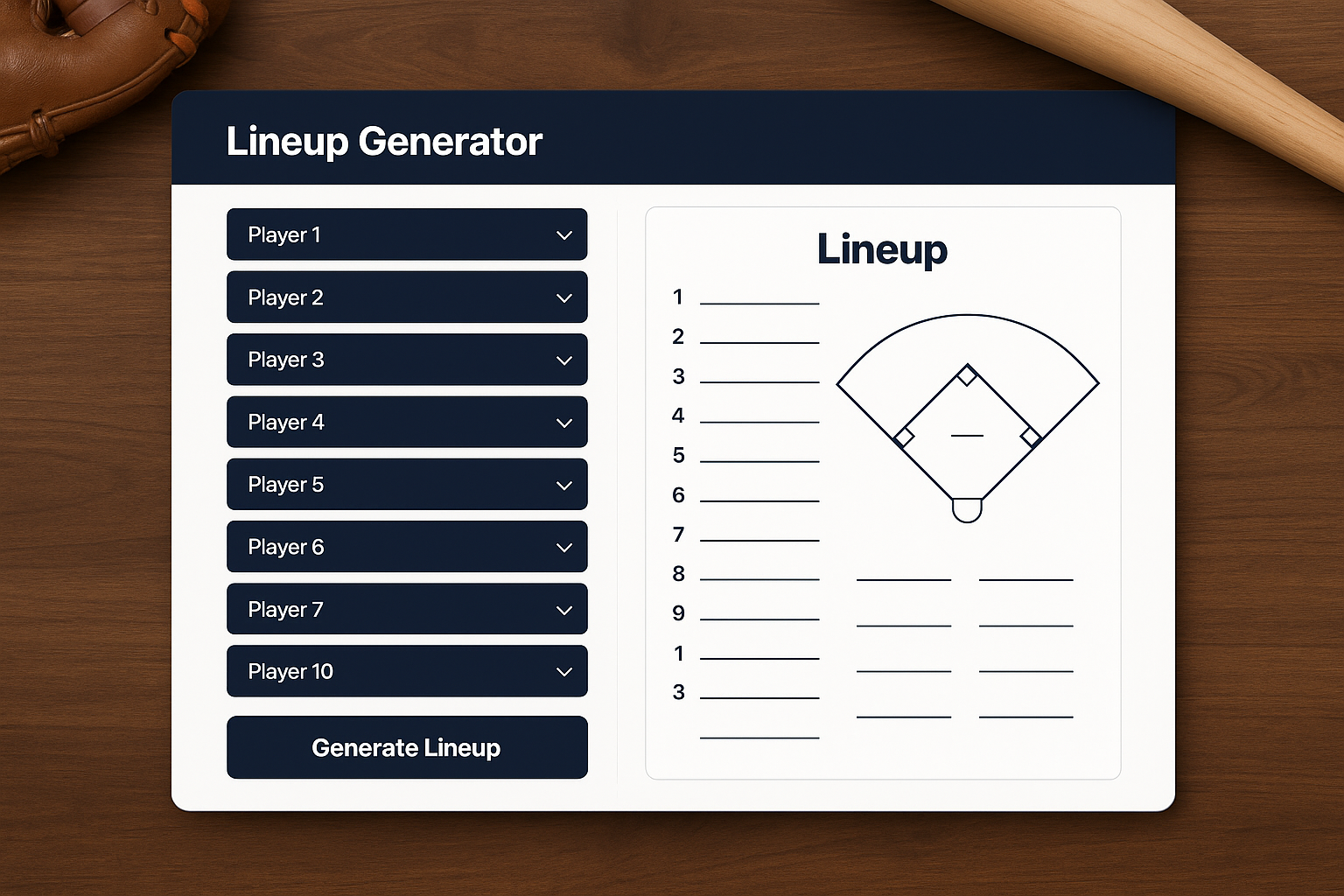How To Create a Winning Baseball Lineup for Offense and Defense

How To Create a Baseball Lineup as a Coach
Congrats, you've been nominated (or volunteered) to be a coach. Exciting stuff! Now it's your first game and you need to create a lineup but don't know where to start. Building a solid baseball lineup isn't just about picking names from a roster. It's a delicate balancing act of strategy, skill evaluation, and a little creativity. If you're trying to lead your team to success as a coach, understanding how to create your own baseball lineup is your first and most crucial step.
For youth baseball coaches, the challenges go beyond just winning. You've got to balance player development, fairness among a range of skill levels, and keeping every player motivated. Whether you're coaching eager kids, competitive youth leagues, or even softball teams, this guide will lay out the steps to help you create a lineup that performs while keeping the game fun and fair. This article is mostly for new coaches that don't have a ton of experience coaching or playing baseball. But from tee-ball to professional teams, we offer practical advice on setting a strong lineup that any coach can use.
Here's what's covered:
- How to evaluate player strengths and weaknesses
- Things to Consider when creating a lineup for offense and defense
- Adapting your lineup during the game
- Fostering teamwork and clear communication
- Practical lineup examples (and a game-changing lineup generator to make your job easier!)
Why does setting a lineup matter?
Think of your order and defensive alignment like a well-orchestrated symphony. If you don't put the best players in the right spots with a strategy in mind, you're playing out of tune, and the results will show. A good lineup helps your team capitalize on scoring opportunities while holding the opposing down on the defensive side. Now, let's break down how to create your own lineup for your team and become an expert manager in no time.

How to Evaluate Your Baseball Players and Team
Before you even think about writing out a lineup, the first step is to assess and evaluate your players. Building a team strategy hinges on understanding what every player brings to the table. If your league uses a standard 9-player format where the same players hit and play defense, you will need to consider both the player's hitting skills and defensive abilities together. If your league requires all batters to hit, you can evaluate players on their hitting and defense seperately.
Hitting
Assess who your best best hitters are. This will be a combination of contact, power, speed and plate discipline. You may want to rank each player on a scale of 1-10 on the following categories to help inform your decision.
Contact: Who hits the ball most often and who swings and misses a lot. Not only do they hit the ball, is the contact solid. Your best contact hitters will consistently hit line drives and can hit the ball to all fields. During practice and games, keep track of hits and outs. Your best contact hitters will hit for average and won't strikeout.
Hitting Power: Who's driving the ball deep into the outfield or over the fence? Power hitters may sacrifice contact for power. If you have access to exit velocity and launch angle, these players will have the highest speeds and have higher launch angles.
Speed: Assessing speed is straight forward, but can also require more thought than you initially think. So how can a baseball coach determine it's fastest players? You can time players based on their home to 1st speed or have them run around the bases at full speed and time that. If you want to get real exact, have the player swing first and run the bases for that timing. Many people don't realize that the player's swing, what side of the plate they hit from, and how well they round the bases can make a big impact on these times.
Plate Discipline: A coach can assess plate discipline by observing a player's ability to avoid swinging at pitches outside the strike zone. Tracking metrics like walk-to-strikeout ratio, swing-and-miss rates, and on-base percentage can also provide valuable insights. Additionally, reviewing game footage to analyze pitch selection and situational at-bats can help identify patterns in a player's decision-making at the plate.
Fielding
As a long-time coach and professional baseball player, I've found that the best athletes are generally the best defenders. It's a perfect blend of hand-eye coordination, arm strenght, and speed or footwork.
Assess Fielding Skills (Glove): Look for players who can consistently field ground balls and catch fly balls under pressure. Reliable hands are crucial for key defensive positions, especially in the infield. This will often relate to hand-eye coordination.
Evaluate Arm Strength and Accuracy: Strong, accurate throws are essential for determining your defensive positioning on the baseball diamond. Test players for their ability to make long, precise throws by practicing throws from third base to 1st base and from the outfield to home.
Measure Speed and Range: Identify players with quick reactions and the ability to cover ground effectively. Speed and range are key for outfielders or any position requiring quick defensive movement. There are players who can have good range and quick feet, but don't have a great top speed in the outfield. Keep note of this.
Lastly, you will want to consider if the player is right-handed or left-handed. Especially at higher levels, there are certain positions that right-handed players can play that left-handed players can't, such as the 3rd base, shortstop, second base and catcher. Unfortunately, the defensive side of the game of baseball is biased towards right-handed players, but that doesn't mean being a left-hander doesn't have its advantages in the sport.
Creating a Baseball Lineup for Offense and Defense
The art of setting a great lineup lies in harmony between batting and fielding. Too much focus on one can leave your team vulnerable on the other side.

Offensive Strategy
Place your best contact hitter with good plate discipline and speed in the leadoff spot, followed by someone who can move the runner over by making contact in the two-hole. You want your 1st two hitters to set the tone for the rest of the lineup. They should have the highest on base percentages for your power hitters to drive them in.
Put your best overall hitter in the third spot to bring in runs. This normally looks like a strong blend of contact, power and plate discipline. Speed is a plus, but definitely not the biggest offensive skill to consider.
Your best power hitter serves as the cleanup batter in position four. Typically this is someone who is also a strong contact hitter and also has good plate discipline like your 3rd batter.
Slots five and six should go to hitters who can capitalize on remaining opportunities to advance baserunners. These hitters would be your next in line for cleanup hitter if they haven't already been placed.
Reserve the lower batting order (7-9) for players with developing skill levels or reserve players. Even here, speed is a plus to avoid clogging the basepaths.
Other considerations when setting a baseball lineup for your team:
Does the player hit right handed, left handed or switch. At higher levels, you may want to avoid putting players of the same hand dominance together in the lineup to avoid matchup problems.
If more than nine players bat, you may want to consider mixing in better hitters towards the end of the lineup so that there are no holes to avoid losing momentum in key spots.
In youth baseball or less competitive leagues, feel free to randomize your lineup and rotate players around in different games to provide equal playing time and equal at bats to all players.
Defensive Strategy
Secure your infield with skilled shortstops and second basemen who possess strong hand-eye coordination and reliable fielding skills. Your shortstop is generally your best athlete with the best glove, arm and range. Your second basemen should have a good glove and range, but will not need a good arm. These positions require players who can consistently handle ground balls and turn key defensive plays under pressure. Right-handed players are typically better suited for these roles.
Reliable corners (first and third base) need, above all, steady hands. Your 3rd baseman will need a strong arm to make long, accurate throws when needed. You can sacrifice range at these positions as they are closest to the batter and will not need to cover much ground.
Outfield success depends on range and arm strength. Identify players with quick reactions and the ability to cover ground effectively. Catching a fly ball is objectively easier than catching a grounder, so glove work is not as vital. Your fastest player should play in Center Field to cover both gaps in the outfield. Typically, the right fielder gets the ball the least, especially at younger levels. At higher levels, your right fielder should have a stronger arm than your left fielder because they will need to make the long throw to 3rd base. A strong, accurate throwing arm is especially vital for cutting off extra bases and making plays at home plate.
Pitching mastery requires both power and precision. A great pitcher isn't just about throwing fastballs at blazing speeds—it's about control, accuracy, and the ability to outsmart batters. The art of pitching lies in delivering the ball with pinpoint precision while mixing up speeds, spin, and locations to keep hitters guessing. Developing a strong arm is essential, but it's equally important to hone control and consistency through practice and discipline. Pitching is a learned skill that takes years of refinement, combining physical strength with mental focus to dominate on the mound.
Catching is often referred to as the backbone of the team, and for good reason. A great catcher isn't just there to receive pitches—they're the on-field strategist, constantly analyzing the game from a unique perspective. Their job goes beyond physical skill; they need sharp instincts, quick reflexes, and a killer arm to keep runners in check. Similar to 3rd base, they should have good glove skills and a strong arm to keep the base paths in check.
Key Tip: A balanced team ensures no area feels like a liability. Defense saves runs; offense scores them.
Practical Lineup Templates and Examples
To simplify creating a great batting order, here are a couple of useful lineup templates you can adapt based on skill levels.

Batting Lineup Examples
- Best contact hitter with plate discipline and fast baserunner (leadoff OBP)
- Consistent contact hitter (high OBP)
- Best overall hitter
- Power hitter (cleanup)
- Second-best power hitter
- Balanced hitter with some speed
- Best remaining contact hitter
- Defensive or confidence builder
- Speedy hitter prepping for the next rotation
Note: If your lineup has more than 9 players and all players bat, fill your final spots with the remaining players in order of hitting ability from best to worse.
Defensive Baseball Alignment Examples
Pitcher (P): Your most reliable and consistent thrower, someone with good control, stamina, and the ability to mix pitches effectively. At the youth level, your pitchers will be the strongest and most accurate arms.
Catcher (C): Quick reflexes and a strong arm are essential. They should be vocal leaders, coordinating the defense and managing the pitching staff.
First Baseman (1B): A tall, strong fielder with good catching skills and the ability to stretch for throws. You may want to place a less mobile player here as the first basemen will do the least amount of running.
Second Baseman (2B): Quick and agile with a good glove, capable of turning double plays and covering ground between first and second.
Third Baseman (3B): The "hot corner" requires quick reaction times and a strong arm to make long throws across the diamond.
Shortstop (SS): Your most athletic and versatile player—quick, with excellent range, throwing accuracy, and game awareness.
Left Fielder (LF): Agile with good speed and reliable catching abilities; they should also have a decent throwing arm for plays at home.
Center Fielder (CF): The fastest player with excellent range and leadership skills to cover more ground and back up the corner outfielders.
Right Fielder (RF): Typically needs a strong arm to throw runners out at third or home, along with solid catching and tracking ability.
Note: Adjustments can be made depending on players' skill levels and team strategy. Always play to your team's strengths!
Adapting to Different Game Situations
Games are unpredictable. Injury? A pitching change? Maybe the score is razor close with your fastest baserunner stranded on deck. That's where a flexible game plan comes in.
Scenarios That Call for Changes
- Late-Game Lead: Bring in defensive-minded players to preserve the score.
- Momentum Swing: Is the opposing pitcher struggling with command? Tell your players to take a pitch until the pitcher throws his first strike.
- Rotating Players: Keep energy high by subbing in fresher athletes or trying out different field positions.
Prepare for all possibilities by keeping your players motivated and ready to step up when the game gets tough.
Build Confidence with Smarter Lineups
To create a winning team, you need more than talent. You need a system that maximizes every player's potential, ensures balance, and adapts to the nuances of the game. Start by understanding your players' strengths, balancing offense and defense, and staying flexible under pressure.
But above all else, set your players up for success. From heartfelt communication to morale-boosting rotation strategies, your lineup is more than batting order; it's a blueprint for team cohesion.
Want to save hours organizing lineups? Try the free lineup generator from DugoutEdge to create professional, balanced lineups in just a few clicks. It's game day prep made simple.
// Metadata is managed via frontmatter and should not appear in the article body. // Section removed to avoid showing SEO tags to readers.
About the Author
Experienced baseball coaches with a passion for player development and team success
Ready to Generate Your Perfect Lineup?
Try our free softball and baseball lineup generator to create balanced, fair lineups in minutes.
Try Lineup Generator